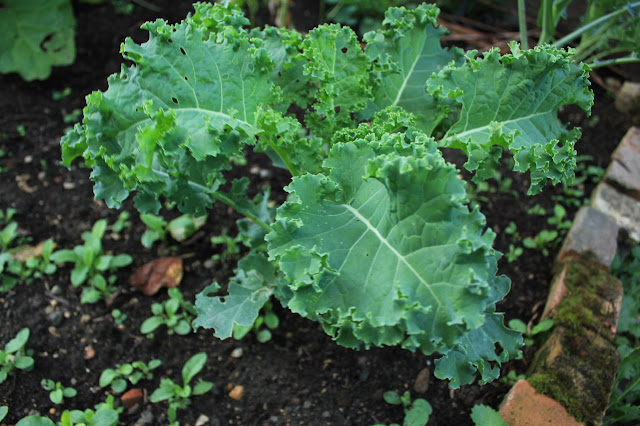 |
| Last kale standing (and yes it is surrounded by self seeded forget me nots that will need to be moved, eventually) |
Honestly, there are times when I wonder why I grow veg. With my small veg patch, my efforts are hardly a step towards self-sufficiency, especially when plants give up the good fight against pests, predators and precipitation (rain). (I do love a bit of alliteration.) But, then again, I’m an optimist by nature and have learned to roll with the heartache of seeing weeks of nurturing wiped out.
As we’ve come to expect in this very British of summers, variable weather conditions have favoured slugs and snails this past week, although I must say that lovely rain has left all the greenery looking very lush, even if my kales and cabbages have all but disappeared. Luckily I have a few spares waiting in the wings; veg growing is nothing if not a learning curve.
Yesterday was one of the brighter, yet chillier, days (perfect weather!) so I was able to grab a few photos in the evening as I inspected the patch after work.
Ah! The waiting game as tomatoes gradually ripen ... they would get there quicker if grown in the warmth of a polytunnel or greenhouse but I don't have that luxury. Mine are chosen for their ability to be grown outdoors - hellooo again, British weather! Dare I keep my fingers crossed and hope for another blight free year?
 |
| Plum. Singular. |
And speaking of digging things up, the broad bean plants can come out; these were a major fail this year. I’ve never had a problem with broad beans but this year the pods refused to swell - probably the unexpected heatwave and not enough watering. The delicious primavera risotto that I make with home grown broad beans, asparagus and peas will have to wait until next year.
Turning resolutely away from the disasters, let’s look at my raspberry patch. I mulched around the canes with some of my Hotbin compost earlier year and, together with regular bouts of heavy rainfall, the difference is noticeable. The first clusters of large firm fruits have ripened - even though they're an autumn fruiting variety - several small handfuls have (in time honoured tradition) been picked and eaten straightaway and I’m hopeful of a steady crop in the weeks ahead. This variety, by the way, is Polka.
So, not all bad news then ...
৹৹৹৹৹৹৹৹৹৹৹৹৹৹
This week I'll be filling gaps in the veg patch by sowing
- two varieties of spinach - a hardy winter cropping variety that can be sown from now until the end of September, plus a vigorous summer variety for baby leaves.
- chard - can be sown again, now we're past midsummer. This sowing will give me baby leaves for salads and larger leaves in autumn and winter. Pink Passion for colour and Fordhook Giant for flavour.
- Coriander - delicious in salsas, salads and the lentil dhal that I make regularly. I'll be sowing this now until the end of August and hope the plants mature in time for some seeds after the pretty flowers.
- Plain leaved parsley - this is a last chance sowing as the window for outdoor sowing is March to July, although the temperatures now are not dissimilar to those in April. I chop flat leaved parsley into just about all savoury food so like to have some on the balcony and in the veg patch.
- Carrots - I sowed another batch of carrots last week; this time I used Extremo (Mr. Fothergills), a variety which crops over winter. I've not grown carrots over winter before but am really quite excited at the prospect of harvesting carrots in the colder months ... allegedly until April, if what I read comes true.






